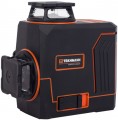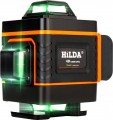Operating temperature
The temperature range at which the device is guaranteed to work for a sufficiently long time without failures, breakdowns and exceeding the measurement error specified in the characteristics. Note that we are talking primarily about the temperature of the device case, and it depends not only on the ambient temperature — for example, a tool left in the sun can overheat even in fairly cool weather.
In general, you should pay attention to this parameter when you are looking for a model for working outdoors, in unheated rooms and other places with conditions that are significantly different from indoor ones; in the first case, it makes sense to also make sure that there is dust and water protection (see "Protection class"). On the other hand, even relatively simple and "myopic" levels / rangefinders usually tolerate both heat and cold quite well.
Tripod thread
The standard size of the thread used to mount the level/rangefinder on a tripod (if available). This option can be useful if you already have a surveying tripod that you want to use with the tool.
The most popular options in modern devices are 1/4" and 5/8". It is worth noting that 1/4" is a standard size for
photographic equipment - accordingly, levels with such a thread can be installed even on ordinary
photographic tripods.
Diode emission
The wavelength of the radiation emitted by the LED of the level or rangefinder; this parameter determines primarily the colour of the laser beam. The most widespread in modern models are LEDs with a wavelength of about 635 nm — at a relatively low cost, they provide bright red radiation, giving a well-visible projection. There are also green lasers, usually at 532 nm — the marks from them are even better visible, but such LEDs are quite expensive and rarely used. And radiation with a wave longer than 780 nm belongs to the infrared spectrum. Such a laser is invisible to the naked eye and is poorly suited for leveling, but it can be used in rangefinders — of course, with a viewfinder (see "Type" for more details).
Horizontal projections
The number of
horizontal projections that a laser level can give out during operation. As in the case of vertical ones (see above), this parameter does not describe the number of geometric planes, but the number of individual work items for projecting horizontal lines. In this case, the projected plane is usually one, and several elements for it may be provided in order to expand the sector covered by the device. For example, a traditional laser level (see "Type") with 4 horizontal projections may be able to cover a full circle of 360 ° — like a rotary (see ibid), but at a significantly lower cost. Of course, there is no need to talk about a full-fledged replacement, because. the power and range of such devices are also not very high; but for work in rooms with distances of several metres, where at the same time wide coverage is important, the usual model with several projections is often preferable to the rotational one. Rotary levels themselves, by definition, have one horizontal projection.
Nadir
Nadir in this case is called a point projection directed vertically down.
By itself, such a projection can be used, in particular, for making holes on the same vertical in ceilings located at different levels. It is enough to make one of the holes, install a level above it — and the laser beam going vertically downwards will indicate the location of the next hole. And in devices that also have the zenith function (see above), the marks from the zenith and nadir projections are located strictly one above the other. This is very convenient when marking the floor and ceiling at the same time for racks, partitions, etc.
Compensator locking
Ability to disable the compensator installed in the level. To be more precise, we are talking about the ability to disable the self-leveling system (recall, it is used to automatically bring the device to the horizontal during initial installation).
Blocking the compensator can be useful in two cases. The first is transportation: compensators are rather delicate mechanisms, and when switched on, they do not withstand the shocks and shocks that the device can be subjected to when moving from place to place. The second case is the installation of the device at an angle, when bringing it to the horizontal is simply superfluous.
Display
Own screen on the device body.
All
displays are used to display various additional information, which makes control more convenient and clear compared to
models without displays ; but the specific functionality and features of the screen may vary, depending on the type. There are black and white options,
backlit displays,
color and even
touch screens. More details about each:
— B/W without backlight. The simplest and most inexpensive type of display: a black-and-white LCD sensor without its own backlight. Despite their overall simplicity, such screens can have quite extensive capabilities: technically, they can display data related to the operation of the device (for example, the results of rangefinder measurements), and other additional information, including quite specific ones. In fact, the only thing that b/w displays are not suitable for is displaying images from a digital camera. In practice, the functionality of the display is selected according to the capabilities of a particular device. As for the lack of backlighting, this feature makes it difficult to use in low light conditions, but it reduces the price and power consumption. In addition, under the sun or other bright lighting on advanced backlit screens the image may “fade”, while on the simplest black and white screens wi
...thout backlight it, on the contrary, becomes even clearer.
— B/W with backlight. Black and white screens equipped with backlight systems. Note that this category actually includes two types of displays: traditional black-and-white LCD matrices in the “black image on a white background” format, supplemented by an external lighting system, as well as single-color screens in the “light image on a black background” format, where the light itself can glow. image. Be that as it may, such displays can be used without restrictions in low light, but the downside of this is increased power consumption - especially in models where the backlight is constantly on.
- Colored. The functionality of color displays can be different - from the simplest LCD screens, capable of displaying only a few primary colors (for example, highlighting the most important numbers on the screen in a different color), to full-color matrices (like tech used, for example, in laptops). The first type is somewhat more convenient and clearer than the b/w displays described above, costs a little more, but has no other differences. The most advanced color screens, in turn, can even display a picture from a digital camera - and, in fact, they are mainly used in devices equipped with such cameras.
- Touch. The most advanced type of display. Such screens are almost always made in color and equipped with backlighting, and touch controls also allow them to be used to control the device (similar to what happens in smartphones and tablets). In terms of control, touch screens are more convenient and intuitive than traditional panels with buttons, switches, etc.; they are much better suited to handle the abundance of functions, and also provide some additional capabilities that are not available with traditional controls. On the other hand, such equipment is not cheap, and it simply does not make sense to use it in relatively simple and inexpensive devices - for such models, more affordable displays, even the simplest black and white ones, are quite sufficient. Therefore, the presence of a touch screen is almost guaranteed to be a sign of a high-end device with an abundance of functions.IP protection rating
The level of protection against harmful influences (in the first place — the penetration of foreign objects) that the body of the level / rangefinder provides in accordance with the IP standard. This standard describes two separate characteristics — protection against solid objects and against water. They are designated respectively by the first and second digit after the IP index; the higher the number, the higher the degree of protection.
Considering that levels and rangefinders usually have to work on construction sites where there is a lot of dust, the minimum level of protection against solid objects for such tools is the fifth. It allows some dust to get inside, but in such a way that it does not affect the performance of the device. The maximum level of dust resistance is 6, which implies complete protection from solid particles.
The second characteristic, protection against moisture, in levels and rangefinders is usually indicated starting from level 4. Officially, it provides protection "against spray from any direction", in fact this means that it can be used in moderate rain with strong winds — a useful point in that if the tool is to be used outdoors. Level 5 allows operation during storms and downpours, a device of the sixth class can withstand being hit by a wave, the seventh — a short-term immersion under water up to 1 m, and the eighth — even a long stay under water. However, for a conventional construction tool, too high water resistance i...s usually not required.
Actually, the most popular option in modern construction tools is the IP54 class: it is quite enough even for work in bad weather, while such cases are relatively inexpensive. There are also more protected models, but less often.
It is also worth noting that a certain level of dust and water protection in itself is usually provided even in devices that do not have an IP marking. The absence of this index does not necessarily mean the absence of protection — it only says that the case has not been officially certified according to the IP standard. But if you need an additional guarantee of reliability, you should still pay attention to certified options.
Operating time
Operating time of the device on one battery charge.
It is worth considering that these figures are quite approximate, since the operating time is measured under certain standard conditions (usually continuous operation at nominal power). And since in practice conditions may differ markedly, the operating time may turn out to be noticeably shorter or longer than stated. In addition, if the device uses replaceable batteries (AAA, AA and the like), then autonomy will also depend on the quality of the specific batteries/accumulators. Nevertheless, based on the data specified in the characteristics, it is quite possible to evaluate the capabilities of specific models and compare them with each other: the difference in the declared operating time, as a rule, proportionally corresponds to the difference in practical autonomy under the same conditions.
We also note that the operating time is specified mainly for levels; in rangefinders another parameter is more often used - the number of measurements (see below).

